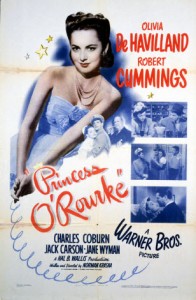When one asks one to name an Olivia de Havilland picture, there are a few which surely come up most frequently. Among these would surely be Gone with the Wind, Captain Blood, The Snake Pit, The Heiress, The Adventures of Robin Hood, and even perhaps even Hush…Hush Sweet Charlotte from the “younger folks.”
One which probably ranks among the rarer (or at least less frequently mentioned) of her many pictures is Princess O’Rourke, released in 1943 though filmed roughly a year earlier. It was filmed at the near to the very end of her contract with Warner Brothers, and in fact ultimately was the last film actually released which she made for Warners while still under contract to them.
This excludes the dismal Government Girl, also released in 1943 but by RKO pictures. De Havilland was loaned out to RKO for the picture surely as some punitive measure from Jack Warner himself for Olivia’s outcry over her lack of substantial serious roles.
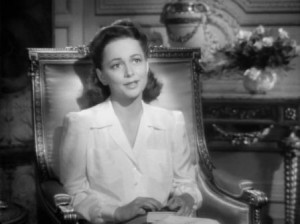 Princess O’Rourke probably didn’t figure too much in any final fallout over her contract and the resulting “de Havilland decision,” as the die was cast well before, with only the final end game yet to be played.
Princess O’Rourke probably didn’t figure too much in any final fallout over her contract and the resulting “de Havilland decision,” as the die was cast well before, with only the final end game yet to be played.
That being said, Princess O’Rourke isn’t bad and shows Olivia in a somewhat rare role playing the lead in a romantic comedy. Written and directed by Norman Krasna, it is a fine if somewhat dated story which still holds a few chuckles.
This is the first of only three directorial efforts by Krasna, as evidently he preferred writing. This surely paid off here as he won the Academy Award for the script for this film and deservedly so, beating out Air Force, In Which We Serve, The North Star, and So Proudly We Hail for the statuette.
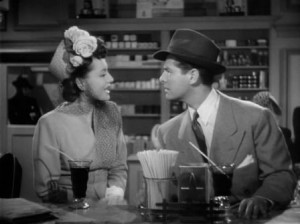 De Havilland is an exiled Princess- exiled presumably due to the Nazi occupation of her home country, although this is never explicitly stated. She has almost made herself a recluse by choice. In preparation for a potential flight to San Francisco, she takes several batches of sleeping pills in an attempt to knock herself out for the flight and quell her fears of flying.
De Havilland is an exiled Princess- exiled presumably due to the Nazi occupation of her home country, although this is never explicitly stated. She has almost made herself a recluse by choice. In preparation for a potential flight to San Francisco, she takes several batches of sleeping pills in an attempt to knock herself out for the flight and quell her fears of flying.
However, due to weather the flight turns back but on landing she is out cold from the drugs. To complicate matters, she’s flying under an assumed name so the flight crew cannot find anyone to take her for the night once they return.
De Havilland’s performance during her stupor is one of the highlights of the film, as her slurred speech, rolling eyes, and vapid lapsing in and out of French are a joy to watch. How she or her costar in these scenes Robert Cummings doesn’t crack up is beyond me. In many cases she is only a few inches from his face- all rolling eyes and flopping head.
Ultimately they fall in love, but he thinks she is just another refugee working as a maid and has no idea she is royalty. Ultimately all becomes clear as it is explained to him. If there is a weakness in the story, it is here. Once the truth is exposed we delve a bit into unreality. Eventually the unreality takes over.
As Cummings’ commoner tendencies are addressed and he is schooled in the more proper aristocratic ways of life, he somehow ends up at the White House with Olivia and her domineering Uncle. Evidently the young Princess is a frequent and preferred guest of FDR. I don’t recall FDR ever being mentioned by name, but he presence is certainly implied.
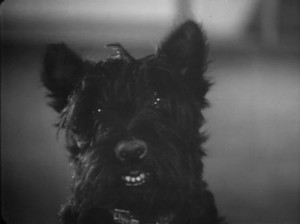 Fala, his dog, however, is here. Fala plays a cloying if endearing role as a messenger towards the end of the picture, resulting in FDR’s summoning of a Supreme Court Justice (Harry Davenport) from bed to get the couple hitched for good.
Fala, his dog, however, is here. Fala plays a cloying if endearing role as a messenger towards the end of the picture, resulting in FDR’s summoning of a Supreme Court Justice (Harry Davenport) from bed to get the couple hitched for good.
Finally married, Cummings bumps into an unseen butler and tips him as the newlyweds leave the White House. I haven’t been able to confirm it, but some think this butler is in fact the real FDR behind the door. Seems doubtful to me, but stranger things have happened. Some say the final scenes were filmed on location at the White House, but this seems hard to believe. One would hope the leader of the free world had more important things to do in 1942.
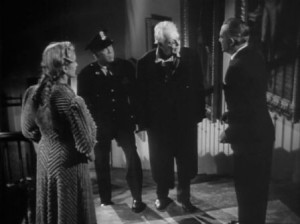 Although de Havilland carries the picture and is in almost every scene, Robert Cummings comes a close second almost as her straight man. He wears his emotions on his face and alternatively is perplexed, angered, or amused but his constantly evolving (and exponentially mutating) relationship with the Princess Maria. The support is strong as well from the likes of Jane Wyman, Charles Coburn, and Harry Davenport.
Although de Havilland carries the picture and is in almost every scene, Robert Cummings comes a close second almost as her straight man. He wears his emotions on his face and alternatively is perplexed, angered, or amused but his constantly evolving (and exponentially mutating) relationship with the Princess Maria. The support is strong as well from the likes of Jane Wyman, Charles Coburn, and Harry Davenport.
You can reach out and get Princess O’Rourke from the Warner Archives, and it isn’t a bad time in the slightest. The characters have depth and development in even this slightly lesser WB entry. Although the values and some of the situations haven’t aged well, it is still nice to films made from a time when these same things did matter.
